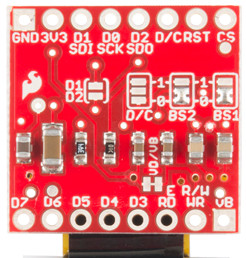Micro OLED Breakout Hookup Guide
Breakout Board Overview
Pin Descriptions
In total, the Micro OLED Breakout provides access to 16 of the OLED's pins. Fortunately, though, you'll only need about half of them to make the display work.
The top row of pins (in the image above) breaks out everything you'd need to interface with the OLED over an SPI or I2C interface. Those pins are:
| Pin Label | SPI Function | I2C Function | Notes |
|---|---|---|---|
| GND | Ground | Ground | 0V |
| 3V3 (VDD) | Power | Power | Should be a regulated 3.3V supply. |
| D1 (SDI) | MOSI | SDA | Serial data in |
| D0 (SCK) | SCK | SCL | SPI and I2C clock |
| D2 (SDO) | MISO | — | Can be unused in SPI mode. No function for I2C. |
| D/C | Data/Command | I2C address selection | Digital pin to signal if incoming byte is a command or screen data. |
| RST | Reset | Reset | Active-low screen reset. |
| CS | CS | — | SPI chip select (active-low) |
The pins on the bottom are mostly only used if you need to control the display over a parallel interface. D3-D7 are the last 5 bits of the parallel data bus. E/RD acts as either an enable/disable pin, or a read/write control, depending on the parallel bus configuration. The RW/WR pin is either used as a read/write control or a write latch.
The VB pin allows you to individually power the VBAT line of the display. The supply for VBAT should be between 3.3V and 4.2V (LiPo battery-ish supply). If you'd like power this line individually, pay extra-special attention to the VD/VB jumper section below.
Those bottom eight pins were simply broken out for complete-ness. If you're controlling the display via either SPI or I2C, you can safely ignore them.
Setting the Jumpers
With the board flipped over, you'll notice there are five jumpers. The majority of these jumpers are used to switch between SPI and I2C mode. As the board ships, these jumpers are set to configure the display in SPI mode.
Here's an overview of each jumper, moving from left-to-right, top-to-bottom in the picture above:
- D1/D2 -- This jumper can be used to short D1 to D2. If you want to use SPI, leave this jumper open. If you're using I2C, short the jumper. By default this jumper is open.
- D/C -- This jumper can be used to short D/C to either 3.3V (1) or 0V (0). In I2C mode, the D/C pin sets the 7-bit address of the display. In SPI mode this jumper should be left open, as the D/C pin needs to be toggled to determine if an incoming byte is data or command.
- BS2 and BS1 -- These pins on the OLED determine which interface you're using to control the OLED. With the two signals, there are four possible combinations:
BS2 BS1 Interface 0 0 SPI 0 1 I2C 1 0 8-bit Parallel (6800) 1 1 8-bit Parallel (8080) - VD/VB -- This jumper shorts the digital power supply (VDD) to the battery power supply (VBAT). Because both of these supplies can be powered at 3.3V, an easy one-supply solution is to short them together and provide them a single supply. If you need to power the digital supply at something lower, like 1.8V, you may need to cut this jumper and provide two supplies.
That brief overview should cover the 99% use case. Consult the schematic and the notes therein if you have any questions about jumpers or pins.
